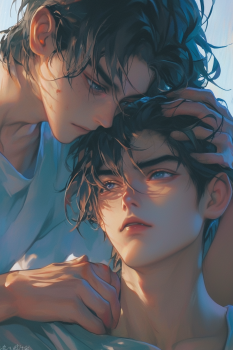Chapter 9
It was as if a sophisticated computational system had caught a keyword—Edward Harris immediately asked, “What exhibition?”
The words Eric Wright had said that afternoon surfaced in his mind; he had mentioned attending something, then changed his mind.
“An installation art exhibition.” Elvis thought he was eager for talent and generously shared the information with him. Even though he had little hope, he still wished him luck.
After receiving the exhibition details, Edward Harris sat quietly for a minute. In the end, he called Carl, asked him to cancel the flight for the next morning, book him a ticket to the exhibition, and postpone all of tomorrow’s reschedulable appointments.
He could hear the confusion and hesitation in Carl’s voice over the phone. It was hardly surprising—even he himself didn’t know what he was doing.
Edward Harris found that he couldn’t stop working.
The moment he stopped, the moment his mind had even a sliver of emptiness, he couldn’t help but wonder—what was Eric Wright doing now, who was he talking to, who was he having dinner with, who was he spending this beautiful night with.
Like a dead loop in code, constantly throwing errors, running endlessly, spiraling out of control, never stopping.
He wished someone could help him terminate this code, but it seemed no one could—not even the version of himself in sleep could escape.
After only three hours of sleep, Edward Harris headed to the art museum at eight the next morning and entered the exhibition hall.
It was even larger than he had imagined. Walking into the venue, he saw all kinds of visitors, each appreciating the art exhibits—everyone except himself, the least devout of all. Edward Harris suddenly found it a bit ridiculous that he had actually come here on a whim because of someone else’s words.
Paradoxically, he both hoped for a real encounter and yet didn’t want to meet, didn’t want to see him through a third party.
That would mean there was still a connection between them, and that he and Eric Wright were already completely unrelated.
This wasn’t a solo exhibition. The two-story gallery was filled with installation artworks by many creators, under the theme “Your Birth.”
All of Edward Harris’s time was spent on work; since coming to America, he had hardly visited places like this. He had no time to appreciate art, and was even afraid to do so.
Anything that would remind Edward Harris of Eric Wright, he avoided as much as possible. But even he hadn’t realized that as long as this person appeared, all his defenses would fail, and he would even, embarrassingly, use these tricks to get closer.
Comparing with the photos sent by Elvis, Edward Harris looked around, searching for any sign of Henry Cooper. It seemed unlucky—he had almost searched the entire first floor and still hadn’t seen him.
Going up to the second floor, just as he was wondering if his judgment was off, among the crowd and the artworks, Edward Harris spotted Eric Wright at a glance.
In that moment, he was happy for Eric Wright, because Eric Wright had truly achieved what he wanted.
But he was no longer the person he was yesterday.
Edward Harris stood there in a daze, not taking another step forward.
Eric Wright was at a corner of the second-floor gallery, with a small patch of white space for his artwork, bathed in blue light.
It was made up of countless broken butterflies suspended by fine threads, folded from white paper, with faint writing visible on the paper.
Yet, the title of the piece had nothing to do with butterflies; it was called “Net.”
Many installation artworks emphasize the objects being suspended, so lighting is often used to make the fine threads invisible. But this piece was different—completely the opposite, highlighting all the threads.
If you only looked at the thousands of butterflies hanging there, you’d see just butterflies. But if you shifted your gaze to the wall, you’d notice the shadows of the “net” formed by the threads. In the shadows on the wall, every butterfly was completely enclosed by a thread, unable to be free.
Edward Harris could understand it—whether six years ago or six years later, he could always understand Eric Wright’s work.
The butterflies were not butterflies, but freedom.
Under the theme “Your Birth,” Eric Wright’s answer was: freedom born in captivity.
Beneath the grand and beautiful installation, he wore a fluffy gray cardigan, a long and large colorful plaid scarf, his face small, chin buried in the scarf, still looking like a student, but his beauty was unmistakable.
Unlike other creators, he didn’t enthusiastically explain the core of his work, but stood quietly to the side, hands at his sides, eyes watching those who came to view his piece.
At this moment, Edward Harris’s ordinary eyesight suddenly became sharp; he could clearly see the subtle expressions on Eric Wright’s face—his nervousness and anxiety, the slight satisfaction when he received affirmation. He also saw the gray-green fountain pen in his hand, and the number “21” posted on the wall behind him—details that were not obvious at all.
But he could see them all clearly.
Edward Harris suppressed his inner thoughts, but still couldn’t help taking another step forward, wanting to see his work more clearly.
Suddenly, he saw Eric Wright turn his head, retreating half a step like a startled animal, and then, upon seeing who had arrived, a faint smile appeared on his face.
That was Henry Cooper.
